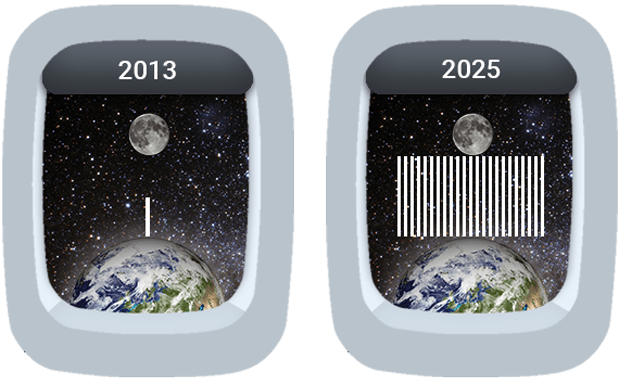Unified Publishing Process
The Digital Universe
The digital universe is not unlike the physical universe in that they are both vast. In 2013, it was estimated to contain around the same number of digital bits as there are stars in the universe. And it is growing fast with all the data we generate and copy.
This figure is expected to increase fortyfold by 2025, to 175 Zettabytes (ZB) or 175 trillion Gigabytes. If that number seems too abstract, consider this: If one were able to store 175ZB onto BluRay discs, then you’d have a stack of discs that can get you to the moon 23 times.


Where is all this data coming from?
Some 7.9 billion people populate the planet, around 5 billion of whom browse the Internet’s 1.9 billion or so websites. With every second that passes, we collectively receive and send around 3 million emails, post 9,681 tweets, launch nearly 95,927 Google searches, watch 91,931 YouTube videos and make 6,098 Skype calls, generating some 129,897 gigabytes of web traffic.
Around 46 billion devices or “things” (tablets, smart phones, cars, refrigerators and gadgetry with sensors) are connected to the Internet says Juniper Research. By 2030, this figure is expected to jump to 125 billion. The average number of connected devices per household in 2020 was 10. Internet of Things (IoT) devices are expected to create over 90 Zettabytes of data in 2025.
By 2025, 49% of all data worldwide will reside in public cloud environments as cloud becomes the new core of storage. And nearly 30% of world‘s data will need real-time processing as the role of the edge continues to grow.
How do we handle this deluge of data?
‘Big data’ is the latest IT catchphrase these days, following hard on the heels of the buzzwords ‘cloud’ and ‘collaboration’ bandied about by many businesses and their IT managers. The general idea may go by many names, but it all boils down to a couple of key challenges. One is, “How do I reel in the big fish in this ocean of data?”
A great deal of effort is being exerted to compile increasingly accurate customer and user profiles, the point being to target products and advertising with greater precision. However, businesses are also looking for better ways of structuring their information processing, so the other big challenge is, “How do we get the right information to the right person at the right place, in the right quality and at the right time?
A symphony of specifics
Companies are not just concerned about managing and analyzing individual content or tidbits of information more efficiently. Many want to combine these specifics dynamically to create new, more complex content. For example, these bits and pieces could be merged to generate larger contracts, documentation for projects, sales collateral, product flyers and corporate publications such as annual reports, customer magazines and employee newsletters in digital formats, as well as in print should demand dictate it.
Publishers and Corporates have been making magazines and corporate publishing for a long time. Although most were launched as printed publications, many have also been available on the web for years. And lately we are seeing more and more tablet and smartphone editions hit the virtual stands.
0
0
0
0
6,098
0GB
Island solutions rather than efficiency
A few generalities about media and corporate publishers’ printed output have held true over the years. The products of linear workflows, they featured elaborate layouts and well-researched articles that delved deep into the details.
Online publications brought other advantages to bear, in particular, streamlined workflows and content that is very much up to date. Each area was an island unto itself, with conventional editorial systems built for one purpose and web CMSs for another.
The revenue divide was vast in the beginning, and efficiency was not a top priority in light of cost-benefit considerations. This situation was exacerbated when tablets arrived on the scene. The first priority was to test the waters to see what could be done and what should be done to attract readers.
If ‘delivering’ systems such as the Twixl or AEM with print and web ‘production’ systems were connected at all, this ‘integration’ was often limited to little more than copy & paste. Much was reformatted and edited manually. It was already a challenge to cater to iOS and iPads with 1024×768 pixels resolution, but that complexity was soon compounded when Android and Windows tablets and Apple‘s Retina Display arrived. Preparing publications individually for so many different formats was hardly a feasible business proposition. Smartphones finally relegated the notion of purely manual workflows to the realm of the absurd.
The result of this fast-rising swell of digital output formats is a deluge of content and data, as well as immense time and cost pressures that threaten to swamp corporates, marketers and publishers.
It is time to chart a new course.
